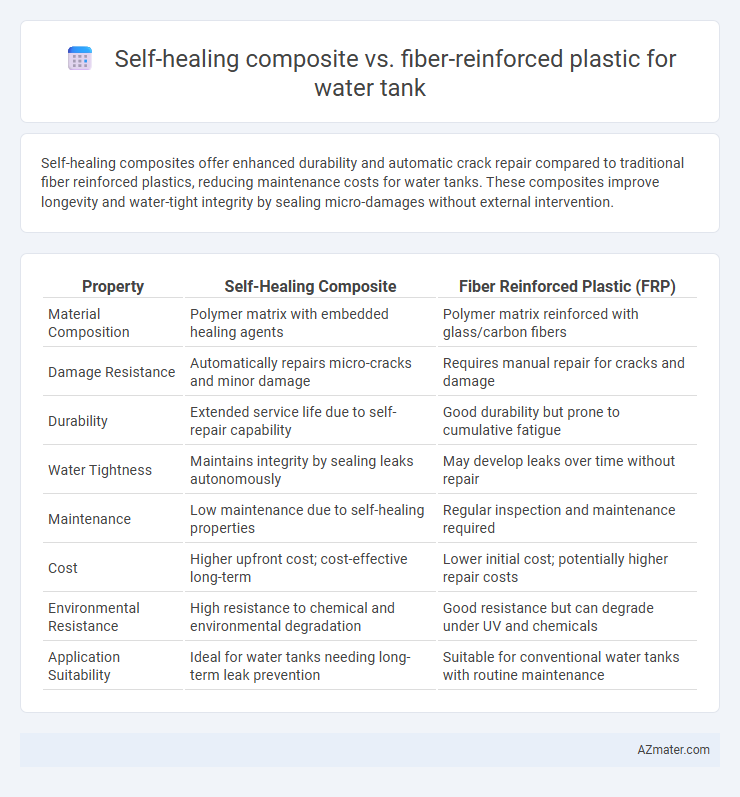Self-healing composites offer enhanced durability and automatic crack repair compared to traditional fiber reinforced plastics, reducing maintenance costs for water tanks. These composites improve longevity and water-tight integrity by sealing micro-damages without external intervention.
Table of Comparison
| Property | Self-Healing Composite | Fiber Reinforced Plastic (FRP) |
|---|---|---|
| Material Composition | Polymer matrix with embedded healing agents | Polymer matrix reinforced with glass/carbon fibers |
| Damage Resistance | Automatically repairs micro-cracks and minor damage | Requires manual repair for cracks and damage |
| Durability | Extended service life due to self-repair capability | Good durability but prone to cumulative fatigue |
| Water Tightness | Maintains integrity by sealing leaks autonomously | May develop leaks over time without repair |
| Maintenance | Low maintenance due to self-healing properties | Regular inspection and maintenance required |
| Cost | Higher upfront cost; cost-effective long-term | Lower initial cost; potentially higher repair costs |
| Environmental Resistance | High resistance to chemical and environmental degradation | Good resistance but can degrade under UV and chemicals |
| Application Suitability | Ideal for water tanks needing long-term leak prevention | Suitable for conventional water tanks with routine maintenance |
Introduction to Water Tank Materials
Self-healing composites offer advanced durability for water tanks by autonomously repairing micro-cracks, extending service life beyond traditional materials. Fiber reinforced plastics (FRP) remain popular due to their high strength-to-weight ratio, corrosion resistance, and cost-effectiveness in water containment applications. Selecting between self-healing composites and FRP depends on factors like maintenance frequency, environmental conditions, and long-term structural integrity requirements.
Overview of Self-Healing Composites
Self-healing composites incorporate microcapsules or vascular networks containing healing agents that autonomously repair cracks, enhancing durability and extending the service life of water tanks. These materials reduce maintenance costs and prevent leakage by restoring structural integrity without external intervention. Compared to fiber reinforced plastics, self-healing composites offer superior resilience against micro-damage, making them ideal for long-term water storage applications.
Understanding Fiber Reinforced Plastics (FRP)
Fiber Reinforced Plastics (FRP) are widely used in water tank construction due to their high strength-to-weight ratio, corrosion resistance, and durability. Composed of a polymer matrix reinforced with fibers such as glass, carbon, or aramid, FRP offers excellent mechanical properties and long service life under exposure to water and environmental stressors. Unlike self-healing composites, FRP does not inherently repair damage, making maintenance and inspection essential to ensure structural integrity over time.
Mechanical Properties Comparison
Self-healing composites exhibit superior mechanical properties for water tanks compared to traditional fiber reinforced plastics (FRP), offering enhanced damage tolerance and crack resistance due to their intrinsic repair mechanisms. These composites maintain structural integrity under cyclic loading and impact stress, reducing maintenance needs and extending service life. Fiber reinforced plastics provide high strength-to-weight ratios but lack the autonomous healing capability, making them more susceptible to progressive damage and potential leaks over time.
Durability and Lifespan Analysis
Self-healing composites exhibit superior durability for water tanks by autonomously repairing micro-cracks, significantly extending lifespan compared to fiber reinforced plastics (FRP), which rely solely on initial material integrity. The self-repair mechanism in these composites reduces maintenance frequency and prevents structural failures caused by water ingress, enhancing overall system resilience. FRPs, while strong and corrosion-resistant, have a limited lifespan primarily influenced by fiber-matrix interface degradation and environmental stressors, making self-healing composites a more sustainable choice for long-term water storage applications.
Maintenance and Repair Capabilities
Self-healing composites for water tanks offer advanced maintenance and repair capabilities by autonomously repairing micro-cracks and preventing leakages, significantly reducing downtime and manual intervention. In contrast, fiber-reinforced plastics (FRP) require periodic inspections and manual repairs, often involving patching or resin application, which can be time-consuming and costly. The self-healing functionality enhances durability and operational efficiency, making it a superior choice for long-term water tank applications.
Cost Implications and Economic Viability
Self-healing composites for water tanks offer reduced maintenance costs by autonomously repairing micro-cracks, potentially extending service life compared to traditional fiber reinforced plastics (FRP). While initial material costs for self-healing composites are higher due to advanced polymers and embedded healing agents, long-term savings from decreased downtime and less frequent replacements enhance economic viability. FRP remains cost-effective for short-term applications, but self-healing composites present a strategic investment for long-term durability and reduced life-cycle expenses.
Environmental Impact and Sustainability
Self-healing composites reduce environmental impact by extending water tank lifespan through autonomous damage repair, minimizing waste and resource consumption compared to fiber reinforced plastics (FRPs) that typically require full replacement after degradation. FRPs involve non-recyclable thermoset resins and energy-intensive manufacturing processes, contributing to higher carbon footprints and landfill accumulation. Sustainable water tank design favors self-healing composites for their potential to lower lifecycle emissions and enhance resource efficiency in municipal and industrial water management systems.
Applications in Water Storage Solutions
Self-healing composites enhance water tank durability by autonomously repairing micro-cracks, reducing maintenance costs and extending service life. Fiber reinforced plastics (FRP) provide high strength-to-weight ratios and excellent corrosion resistance, making them ideal for large-scale water storage tanks in industrial and municipal settings. Both materials improve water containment safety, but self-healing composites offer superior long-term reliability through adaptive damage control.
Future Trends in Water Tank Material Technology
Self-healing composites for water tanks offer enhanced durability by autonomously repairing micro-cracks, reducing maintenance costs compared to traditional fiber reinforced plastics (FRP). Advances in nano-encapsulation and polymer matrix technologies enable these materials to extend tank lifespan and improve resistance to environmental stressors. Emerging innovations prioritize sustainability and smart monitoring integration, positioning self-healing composites as the future standard in water tank material technology.

Infographic: Self-healing composite vs Fiber reinforced plastic for Water tank
 azmater.com
azmater.com